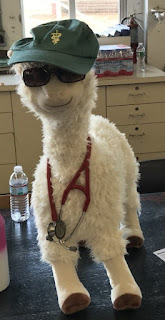Click For Explanation of Case Flow
Click for Test Case Tuesday: Sick Swinehaus Swine
Given the concerning clinical signs and differentials list, the veterinarian immediately calls the state veterinarian to report a disease outbreak and to send samples from the pigs to Plum Island for analysis.
🧫
Plum Island is an island off the state of New York that has an Animal Disease Center that studies and tests samples for foreign animal diseases such as Foot and Mouth Disease and African Swine Fever.
🦠
Plum Island allows for studying these diseases that historically were not allowed to be studied on the mainland due to the fear of the diseases accidentally being brought out of the facility and infecting our animals.
🔬
Plum Island is slated to be closed as a new facility is being built in Manhattan, Kansas to study foreign animal diseases. The goals of these facilities is to diagnose, research, and educate about foreign animal diseases that pose a risk to the United States agriculture and economy.
🥽
African Swine Fever and Foot and Mouth Disease are NOT present in the United States. Foot and Mouth Disease was eradicated from the United States in 1929 and African Swine Fever has never been reported in the United States.
⚗️
All of our livestock are susceptible to these fatal diseases if they were to enter the country.
The results from this testing are below:
Diagnostic Testing Results:
Positive for African Swine Fever 😨
😱
Diagnosis:
🐽African Swine Fever🐽
Pathophysiological Point:
African Swine Fever (ASF) is an extremely fatal viral disease of domestic swine. The ASF virus mostly infects the macrophages/monocytes of the pigs. This causes a huge depletion in the immune cells of the animals. The presentation of ASF is similar to Ebola in humans where the pigs have high fevers and start bleeding from different orifices.
Questions:
Level 1 Questions:
- Explain why the veterinarian contacted the state veterinarian to report the disease outbreak. (HINT: Think about the severity of the pigs' sickness and the information given at the start of this post)
- Explain why the pigs are dying so quickly. (HINT: Think about the physical exam findings and the major finding that was found in the dead pigs' autopsies/necropsies)
- Challenge
question, what do you think should be done on the farm now that African Swine Fever has been diagnosed? (HINT: This disease is 100% fatal in American domestic pigs, there is no vaccination, the disease has never been on American soil, and there is no way to treat this disease. The full answer to this question will be multiple different approaches)
Level 2 Questions:
- Affected pigs are showing the signs of redness throughout their skin. The severe redness noted in these pigs tells us that they are undergoing what process at an increased rate? (HINT: The other signs of this process are heat, swelling, pain, and loss of function)
- Pathophysiologically explain the steps of the above disease process that leads to redness in these pigs. Be sure to mention all molecules, substances, and changes that occur in each step.
- Challenge question, explain how African Swine Fever is similar to the Ebola virus in humans. Be sure to note the pathophysiology, source of infection, physical exam findings, etc. that are similar between the two diseases. (HINT: For this one take the time to find reputable sources to learn more about each disease)
Level 3 Questions:
- Describe
your recommended plan and why you are recommending each part
of your plan. Please answer this question as if you are
explaining it to a the farmer or the general public without a scientific background. (Remember, this will be a sensitive conversation for most folks)
- Please describe the different potential sources of ASF on this farm.
- Please describe the different ways ASF can be prevented from entering into farms, regions, countries, etc.
Day 2 Conclusion
Before Conclusion Caturday think about your...
❓Answers to the above questions
📚 Review Material Related to our pigs' case
Conclusion Caturday: Sick Swinehaus Swine (link will go live Saturday, 11/25/2023)



No comments:
Post a Comment